

Aria: Canticle of the Monomyth. Aria: Canticle of the Monomyth was a role-playing game published by Last Unicorn Games in 1994.
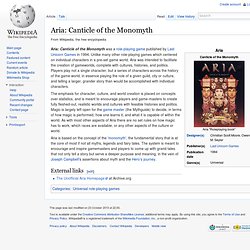
Unlike many other role-playing games which centered on individual characters in a pre-set game world, Aria was intended to facilitate the creation of gameworlds, complete with cultures, histories, and politics. Players play not a single character, but a series of characters across the history of the game world, in essence playing the role of a given guild, city or culture, and telling a larger, grander story than would be accomplished with individual characters. The emphasis for character, culture, and world creation is placed on concepts over statistics, and is meant to encourage players and game-masters to create fully fleshed-out, realistic worlds and cultures with feasible histories and politics. Magic is largely left open for the game master (the Mythguide) to decide, in terms of how magic is performed, how one learns it, and what it is capable of within the world. Basic Fantasy RPG. Gonnerman drew on his previously designed RPG, Project 74,[5][6] as well as some descriptive text from the D&D 3.5 SRD and Castles & Crusades, for material to create Basic Fantasy.[1] The game has been positively received.[7][8][9][10] Criticism of BFRPG has focused on its deviations from B/X D&D, particularly in comparison to Labyrinth Lord, another "retro-clone" RPG.[7] References[edit] External links[edit] Basic Fantasy RPG Home.
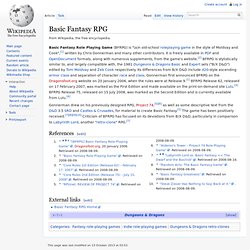
With Great Power... With Great Power... is a Silver Age superhero tabletop role-playing game by Michael S.
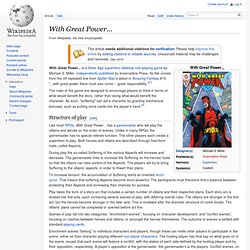
Miller, independently published by Incarnadine Press. Its title comes from the oft-repeated line from Spider-Man's debut in Amazing Fantasy #15, "...with great power there must also come -- great responsibility. The Slayers d20. Cover art The Slayers d20 Role-Playing Game is a 2003[1] role-playing game published by Guardians of Order based on the anime series Slayers.
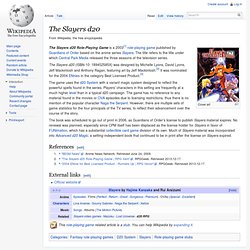
The title refers to the title under which Central Park Media released the three seasons of the television series. The Slayers d20 (ISBN-10: 189452585X) was designed by Michelle Lyons, David Lyons, Jeff Mackintosh and Anthony Ragan, featuring art by Jeff Mackintosh.[2] It was nominated for the 2004 ENnies in the category Best Licensed Product.[3] The game uses the d20 System with a variant magic system designed to reflect the powerful spells found in the series. Players' characters in this setting are frequently at a much higher level than in a typical d20 campaign. The book was scheduled to go out of print in 2006, as Guardians of Order's license to publish Slayers material expires. BattleDragons. BattleDragons is a role-playing game published by Spartacus Publishing in 2002.
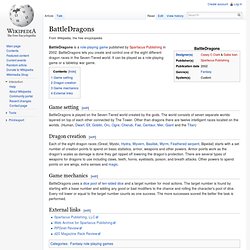
BattleDragons lets you create and control one of the eight different dragon races in the Seven-Tiered world. It can be played as a role-playing game or a tabletop war game. Game setting[edit] Dragon creation[edit] Necroscope. Necroscope is the title of a series of horror novels by British author Brian Lumley.
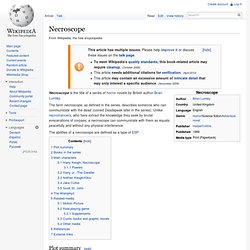
The term necroscope, as defined in the series, describes someone who can communicate with the dead (coined Deadspeak later in the series). Unlike necromancers, who here extract the knowledge they seek by brutal eviscerations of corpses, a necroscope can communicate with them as equals: peacefully and without any physical interference. James Bond 007 (role-playing game) James Bond 007: Role-Playing In Her Majesty's Secret Service was a spy fiction role-playing game, designed by Gerard Christopher Klug, and published by Victory Games (a branch of Avalon Hill), based on the James Bond books and films.
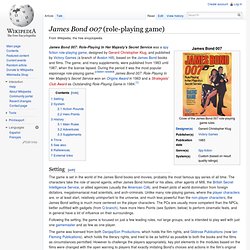
The game, and many supplements, were published from 1983 until 1987, when the license lapsed. During the period it was the most popular espionage role-playing game. [citation needed] James Bond 007: Role-Playing In Her Majesty's Secret Service won an Origins Award in 1983 and a Strategists' Club Award as Outstanding Role-Playing Game in 1984.[1] Following the setting, the game is focused on just a few leading roles, not large groups, and is intended to play well with just one gamemaster and as few as one player. The system requires 6 and 10-sided dice. Mouse Guard. Series one and two of the series have been collected in a single volume each, titled, respectively Mouse Guard: Fall 1152 (ISBN 1-932386-57-2), and Mouse Guard: Winter 1152 (ISBN 1-932386-74-2).

In June 2013, Mouse Guard: The Black Axe (ISBN 1-936393-06-9), a prequel which deals with Celenawe's earlier life, was published. Main story[edit] Petersen signing a copy of Mouse Guard: Fall 1152 at WonderCon 2009. Mouse Guard is set in a world of sentient mice who live in a medieval era, paralleling the same age in human history, though in their world there are no humans. Its stories revolve around a brotherhood of mice known as the "Mouse Guard" who have sworn an oath to serve their fellow civilian mice in times of need, including making safe passage for them through the wilderness and protecting them from predators.[1] "The mice struggle to live safely and prosper among all of the world’s harsh conditions and predators.
Characters[edit] Mouse Guard: Fall 1152[edit] Issue #2 - Shadows Within[edit] The Shadow of Yesterday. The Shadow of Yesterday (or TSoY) is a narrativist sword and sorcery (with optional elements of heroic fantasy) indie role-playing game, designed by Clinton R.

Nixon and published by CRN Games. Notable features[edit] It is notable due to large portion of the game content and its core mechanics, the Solar System [1] have been released under a Creative Commons license, as well as being published using only Open Source tools. Zen and the Art of Mayhem. Zen and the Art of Mayhem is a generic role-playing game system designed to simulate anime, tokusatsu, and action genre worlds.

The core rules systems could be considered a balance between detail and ease of use. The character creation system is fairly detailed allowing for construction of many different and detailed character types. Yet the rest of the rules remain easy and simple to use making it a merger between simple and fast game play, with a characters being well developed and detailed. Weapons of the Gods (role-playing game) Weapons of the Gods uses a custom-designed ruleset called the "Wuxia Action System". The player rolls the number of specified dice equal to the character's skill.
The player then looks for matching dice. For each match, the player multiplies the number of matches by ten and adds the value of the dice in the match. For example, a roll of five dice showing 3,3,6,8,0 is a 23 (or 18, 16, or 10, should the player want a lower result). The Witcher. Books[edit] The short stories in The Witcher series were first published in Fantastyka, a Polish science fiction and fantasy magazine. The first short story, "Wiedźmin" ("The Witcher") (1986), was written for a contest held by the magazine, where it won third place.
The first four stories of the witcher Geralt – and the story "Droga, z której się nie wraca" ("The Road with No Return"), which took place in the same world, but dozens of years before the witcher stories – were originally featured in a short story collection titled Wiedźmin, published in 1990 (out of print and now obsolete; all fifteen short stories were later collected in three books published by superNOWA).
"Droga, z której się nie wraca", along with "Coś się kończy, coś się zaczyna," a non-canon story/alternate ending of the Witcher saga about Geralt and Yennefer's wedding written as a wedding gift for Sapkowski's friends, was later published in the book Coś się kończy, coś się zaczyna. World Tree (role-playing game) World Tree is an anthropomorphic fantasy role-playing game designed by Bard Bloom and Victoria Borah Bloom and published by Padwolf Publishing in 2001. The setting is the World Tree, a gigantic - possibly infinite - tree, with multiple trunks, branches tens of miles thick, and thousands long. World Tree was nominated for Best Anthropomorphic Game and Best Anthropomorphic Published Illustration in the 2001 Ursa Major Awards.
Although combat plays a part in the game, most campaigns benefit from good role-playing skills on the part of the players. Almost all characters can make creative use of spontaneous magic, where characters can invent their own spell from lists of verb-noun combinations. The World Tree is described as a translation of the world's language, from the perspective of a visitor from terrestrial reality (Earth). Weird Wars. Weird Wars is a series of horror role-playing games set during past and future wars and published by Pinnacle Entertainment Group.
The original release, Weird War II: Blood on the Rhine was set during World War II, and utilized the D20 System. The second release, Tour of Darkness was set during the Vietnam War and employed the Savage Worlds rules set.[1] A third release, also for Savage Worlds, Necropolis was set in the future on a war torn planet.
Setting[edit] In the original Weird War II, players play as Allied soldiers during the Second World War. The setting presents a supernatural element, and characters face (and drive) haunted vehicles, fight mutant Nazi soldiers and investigate the supernatural. Hitler and his Nazis have their own magic-users: Blood Mages, who can be amongst the toughest foes the players will face. Blood Mages are essentially Adepts of Evil Alignment, which grants them the power to draw upon the 'innate evil' of places such as Death Camps and battlefields.
CJ Carella's WitchCraft. CJ Carella's WitchCraft, or more informally WitchCraft (ISBN 978-1891153402), is a modern horror role-playing game published by Eden Studios, Inc. It is based on the Unisystem game system and had been previously published by Myrmidon Press.[1] In both cases it was designed and written by C. J. Carella. Warcraft: The Roleplaying Game. Wayfarers (role-playing game) Wild Talents (role-playing game) Wild Talents is a superhero role-playing game published by Arc Dream Publishing and written by Dennis Detwiller, with Greg Stolze, Kenneth Hite, and Shane Ivey, with illustrations by Christopher Shy, Sam Araya, and Todd Shearer. The game was shipped to customers worldwide on December 18, 2006.[1] Violence (role-playing game) Cover art was by Clint Langley. Usagi Yojimbo Role-Playing Game. The Whispering Vault. Sword World RPG. Sword World RPG (ソード・ワールドRPG, Sōdo Wārudo Āru Pī Jī?) Is a Japanese role-playing game[1] created by Group SNE. 10 million copies of the related books including rulebooks, novels and replays have been sold.[2]
Total Eclipse (2011 video game) The World of Synnibarr. Trail of Cthulhu (role-playing game) Setting[edit] Pulp magazine. Terra Primate. Theatrix (role-playing game) Tibet: The Roleplaying Game. The Squared Circle. TWERPS. Spirit of the Century. Teenagers from Outer Space (role-playing game) The Witcher. Tokyo NOVA. Flying Buffalo. Tunnels & Trolls. Pax Draconis. OSRIC. Ninja Burger. Nightlife (role-playing game) Night Wizard! Noctum (role-playing game) Nobilis. My Life with Master. Risus. Sengoku (role-playing game) Sine Requie. Warhammer 40,000 Roleplay. Septerra Core. Sorcerer (role-playing game) Polaris (role-playing game) Pathfinder Roleplaying Game. QAGS. Shatterzone. Prime Directive (role-playing game) Quest of the Ancients. Shard (role-playing game) Pantheon (role-playing game)
Phoenix Command. Reich Star. Puppetland. The Riddle of Steel. Target Games. Mutant Chronicles. Doom Trooper. Warzone (game) Kult. Marvel Comics. Marvel Universe Roleplaying Game. Alshard. Bloodlust (roleplaying game) Dzikie Pola (role-playing game) Human Age. Neuroshima. 3D&T. Rêve: the Dream Ouroboros. Agone. Drakar och Demoner. Kryształy Czasu. Double Cross (role-playing game) Eon (role-playing game) In Nomine Satanis/Magna Veritas. Terra the Gunslinger. Aquelarre (juego de rol) Erdor. The Dark Eye. The Legend of Sword and Fairy. Monastyr. Tagmar.